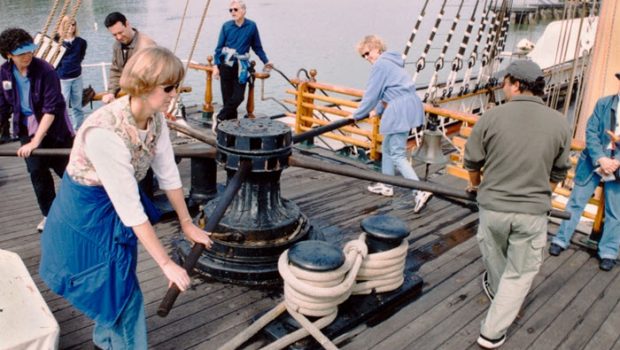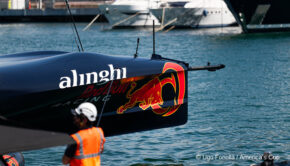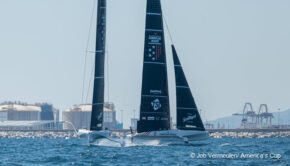America’s Cup: Evolution of power
Published on May 28th, 2020
Dr. Hamish Ross, a legal advisor for America’s Cup teams who completed a PhD at the University of Auckland on the legal issues surrounding the America’s Cup, provides a history lesson on the advances of equipment.
Give me a lever long enough and a fulcrum on which to place it, and I shall move the world, so said Archimedes.
King Hieron of Syracuse asked him to prove it. In the harbour was the Syracusia, a 55-metre ship that had proved impossible to launch even by the combined efforts of many men. Archimedes, who had been examining the properties of levers and pulleys, built a machine that allowed him to single-handedly move the ship, including the complete crew, from a distance.
Pulleys and levers have always helped sailors propel ships since mankind first pushed a vessel from shore. One of the first was the capstan, used by a team of sailors pushing poles around a large ratcheted pulley to haul an anchor (above). Something the author participated in when sailing the replica of HMB Endeavour in 2019.
Some of the first sheet winches, with 1:1 gearing, were in use in yachts in the 19th century. Nat Herreshoff refined them and used winches aboard Reliance, the largest yacht ever to race for the America’s Cup, and these were handed down to Resolute in 1920 and Enterprise in 1930.
It was not until 1959, that the modern top handled winch was invented and sold by Lewmar. Later, multi-geared winches became available and are now common aboard most modern keel yachts.
The sport of sailing has traditionally maintained strict rules against the use of stored power such as the use of engines to help adjust or trim rigging and sails, limiting this to crew manual power only, albeit assisted by the use of levers and pulleys and screws.
More recently, World Sailing permitted Class Rules to fully or partly relax these restrictions, opening up opportunities to use non-manual power aboard racing yachts to power movable keels, adjusting riggings and trimming sails, resulting in bigger loads and more speed.
Interestingly, the Deed of Gift provides only a Challenger’s yacht must be ‘propelled by sails only”, but the Deed has no such requirement for a Defender. Could a Defender use an engine powered yacht?
The highest court to rule on the Deed, the New York Court of Appeals, helps a Defender as it ruled in the Mercury Bay case, “… the deed permits the competitors to both build and construct and race the fastest vessels possible so long as they fall within the broad criteria of the deed. … Any question of sportsmanship and fairness, such as the propriety of races between monohull and multihull vessels, … are not questions suitable for judicial resolution.”
More than a few candles were burned investigating this between 2007-2010!
It was the 2010 America’s Cup match, raced under the terms of the Deed of Gift that brought non-manual power into racing for the Cup. The Defender took the opportunity available to it under World Sailing’s Racing Rules of Sailing, to relax the manual power rule (which it routinely did anyway for some of its racing on Lake Geneva).
This was objected to by the Golden Gate Yacht Club, but it lost this argument in the New York Supreme Court and Golden Gate was forced to belatedly add an engine to help power its yacht. Both yachts raced the 2010 match with a small engine providing additional non-manual power to help sail their huge multihull yachts.
The more recent America’s Cups held in 2013 and 2017, understandably eschewed environmentally unfriendly combustion engines in favor of hydraulically powered systems, where hydraulic power was provided by the crew (grinders) powering pumps to store hydraulic pressure which was bleed off as sails and foils were trimmed.
Emirates Team New Zealand’s decisive innovation in 2017 was the use of more powerful leg power of four cyclors to provide greater power.
In 2021, additional power will be provided by rechargeable batteries providing electrical power to control and trim the foils while the grinders will again be providing hydraulic power to trim sails – but limited to arm power this time!
Will this now make the America’s Cup less athletic than in the past? Peter Burling said, “The grinders this time will have to be at a very high athletic level. The AC75 is a very powerful dynamic boat that is very energy intensive to sail so the demands from the athletes are very high.”
36th America’s Cup
In addition to Challenges from Italy, USA, and Great Britain that were accepted during the initial entry period (January 1 to June 30, 2018), eight additional Notices of Challenge were received by the late entry deadline on November 30, 2018. Of those eight submittals, entries from Malta, USA, and the Netherlands were also accepted. Here’s the list:
Defender:
• Emirates Team New Zealand (NZL)
Challengers:
• Luna Rossa (ITA) – Challenger of Record
• American Magic (USA)
• INEOS Team UK (GBR)
• Malta Altus Challenge (MLT) – WITHDRAW
• Stars + Stripes Team USA (USA)
• DutchSail (NED) – WITHDRAW
Of the three late entries, only Stars+Stripes USA remains committed, but they still must complete the entry fee payment process before they will be eligible to race. They have allegedly made their initial payment but as a late entry challenger under the Protocol, they also have a liability to pay a US$1million late entry fee due in installments by October 1, 2019. However, it is not yet confirmed if they have paid the fee, nor is there any knowledge of a boat being actively built or sailing team training.
Key America’s Cup dates:
✔ September 28, 2017: 36th America’s Cup Protocol released
✔ November 30, 2017: AC75 Class concepts released to key stakeholders
✔ January 1, 2018: Entries for Challengers open
✔ March 31, 2018: AC75 Class Rule published
✔ June 30, 2018: Entries for Challengers close
✔ August 31, 2018: Location of the America’s Cup Match and The PRADA Cup confirmed
✔ August 31, 2018: Specific race course area confirmed
✔ November 30, 2018: Late entries deadline
✔ March 31, 2019: Boat 1 can be launched (DELAYED)
✔ 2nd half of 2019: 2 x America’s Cup World Series events (CANCELLED)
✔ October 1, 2019: US$1million late entry fee deadline (NOT KNOWN)
✔ February 1, 2020: Boat 2 can be launched (DELAYED)
✔ April 23-26, 2020: First (1/3) America’s Cup World Series event in Cagliari, Sardinia (CANCELLED)
✔ June 4-7, 2020: Second (2/3) America’s Cup World Series event in Portsmouth, England (CANCELLED)
December 17-20: Third (3/3) America’s Cup World Series event in Auckland, New Zealand
January 15-February 22, 2021: The PRADA Cup Challenger Selection Series
March 6-15, 2021: The America’s Cup Match
AC75 launch dates:
September 6 – Emirates Team New Zealand (NZL), Boat 1
September 10 – American Magic (USA), Boat 1; actual launch date earlier but not released
October 2 – Luna Rossa (ITA), Boat 1
October 4 – INEOS Team UK (GBR), Boat 1
Details: www.americascup.com











 We’ll keep your information safe.
We’ll keep your information safe.